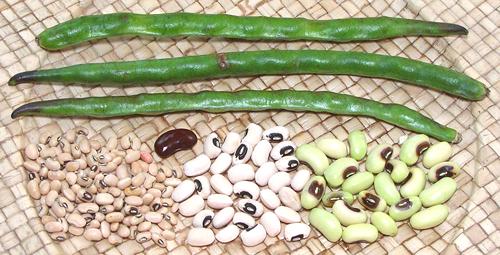 [Black-eyed Bean, Field Peas; Lobiya, Lobia, Rongi, Chawli (India);
family Fabaceae, Vigna unguiculata, subspecies
dekindtiana]
[Black-eyed Bean, Field Peas; Lobiya, Lobia, Rongi, Chawli (India);
family Fabaceae, Vigna unguiculata, subspecies
dekindtiana]
Native to Africa, black-eyed peas are now planted worldwide, particularly in India, Africa, China, the U.S. Southern States, the Caribbean, and California. They are well known in the U.S. for their use in Southern and Afro-American cooking, having been brought over with the slave trade. They are also very popular in Brazil, which has a strong African influence, also from the slave trade.
The photo shows fresh pods (top) about 7-1/2 inches long, but they can get up to at least 9 inches. The tiny dried beans on the left were from India. They were typically 0.30 inch long and 0.15 inch thick. These beans are called "Chawli", but the name Chawli is also used for the larger Black Eyed Peas. In the center are the dried beans common in North America, typically 0.40 inch long and 0.22 inch thick. To the right are freshly shelled beans, typically 0.58 inch long by 0.29 inch thick.
The commercial variety in North America is almost universally the California Blackeye, but other varieties with different color spots and different sizes exist in their native Africa, in India, and in the U.S. Southeast. See also Butter Beans for a Brazilian and Mexican varity.
More on Varieties of Beans.
For uses calling for fresh Black Eyes, frozen are widely available and will do, with just a little less cooking.
For recipes calling for fresh young pods, you can use the closely related Afro-Asian Long Beans, which have much the same flavor and much meatier pods. They are widely available in markets serving Southeast Asian communities, and now even in some supermarkets.